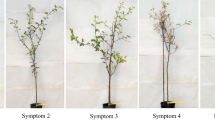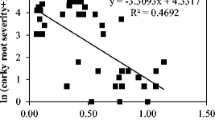Abstract
The interactive effects of citrus root residues and soil fungi on citrus replant problems were investigated. The results indicated that incorporation of citrus root residues in combination with the pathogenic fungiPhytophthora citrophthora, Pythium aphanidermatum andFusarium solani in soil caused more reduction to sour orange growth than did the root residues alone. Subsequent experiments showed that extracts of different parts of sour orange and leachates of some soil fungi increased the disease index of citrus roots grownin vitro. The citrus extracts did not affect growth of the test fungi.
Thus, it appears that allelopathic compounds of plant and microbial origins build up in old citrus soil and may act as predisposal agents for the infection of citrus roots by soil pathogens.
Similar content being viewed by others
References
AlSaadawi I S 1987 Phytotoxins resistance byRhizobium meliloti mutants. Plant and Soil 102, 279–282.
Barnes J P and Putnam A R 1983 Rye residues contribute weed suppression in no-tillage cropping systems. J. Chem. Ecol. 9 1045–1058.
Chou C H and Patrick Z A 1976 Identification and phytotoxic activity of compounds produced during decomposition of corn and rye residues in soil. J. Chem. Ecol. 2, 369–387.
Hartung A C and Stephens C T 1983 Effects of allelopathic substances produced by asparagus on incidence and severity of asparagus decline due to Fusarium crown rot. J. Chem. Ecol. 9, 1163–1174.
Hassan M S, El-Behadli A H and AlSaadawi I S 1989 Citrus replant problem in Iraq. I. Possible role of some soil biotic factors. Plant and Soil 116, 151–155.
Hassan M S, AlSaadawi I S and El-Behadli A H 1989 Citrus replant problem in Iraq. II. Possible role of allelopathy. Plant and Soil 116, 157–160.
Leather G R 1983 Weed control using allelopathic crop plants. J. Chem. Ecol. 9, 983–990.
Patrick Z A, Tousson T A and Koch L W 1964 Effect of crop residue decomposition product on plant roots. Annu. Rev. Phytopathol. 2, 267–292.
Putnam A R and Defrank J 1979 Use of cover crops to inhibit weeds. Proc. IX Int. Cong. Plant Prot., pp 580–582.
Putnam A R, Defrank J and Barnes J P 1983 Exploitation of allelopathy for weed control in annual and perennial cropping systems. J. Chem. Ecol. 9, 1001–1010.
Rice E L 1984 Allelopathy. Academic Press, New York.
Tousson T A and Patrick Z A 1963 Effect of phytotoxic substances from decomposing plant residues on root rot of bean. Phytopathology 53, 265–270.
Author information
Authors and Affiliations
Rights and permissions
About this article
Cite this article
Hassan, M.S., El-Behadli, A.H. & Alsaadawi, I.S. Citrus replant problem in Iraq III. Interactive effect of soil fungi and allelopathy. Plant Soil 116, 161–166 (1989). https://doi.org/10.1007/BF02214543
Received:
Revised:
Issue Date:
DOI: https://doi.org/10.1007/BF02214543




